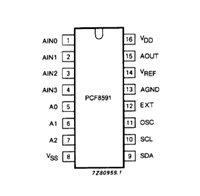SMJ320C50/SMQ320C50
DIGITAL SIGNAL PROCESSOR
SGUS020B -- JUNE 1996 -- REVISED SEPTEMBER 2001
Terminal Functions (Continued)
TERMINAL
NAME TYPE
DESCRIPTION
†
MEMORY CONTROL SIGNALS (CONTINUED)
Write enable. The falling edge indicates that the device is driving the external data bus (D15--D0). Data can be
latched by an external device on the rising edge of WE. This signal is active on all external program, data, and I/O
writes. WE is in the high-impedance state in hold mode or when OFF is active (low).
WE
O/Z
MULTIPROCESSING SIGNALS
Hold. HOLD is asserted to request control of the address, data, and control lines. When acknowledged by the C50,
these lines go to the high-impedance state.
HOLD
I
Hold acknowledge. HOLDA indicates to the external circuitry that the processor is in a hold state and that the
address, data, and memory control lines are in the high-impedance state so that they are available to the external
circuitry for access to local memory. This signal also goes to the high-impedance state when OFF is active (low).
HOLDA
O/Z
Bus request. BR is asserted during access of external global data memory space. READY is asserted when the
global data memory is available for the bus transaction. BR can be used to extend the data memory address space
by up to 32K words. BR goes to the high-impedance state when OFF is active low. BR is used in external DMA access
of the on-chip single-access RAM. While HOLDA is active (low), BR is externally driven (low) to request access to
the on-chip single-access RAM.
BR
I/O/Z
O/Z
Instruction acquisition. Asserted (active) when there is an instruction address on the address bus; goes into the
high-impedance state when OFF is active (low). IAQ is also used in external DMA access of the on-chip
single-access RAM. While HOLDA is active (low), IAQ acknowledges the BR request for access of the on-chip
single-access RAM and stops indicating instruction acquisition.
IAQ
Branch control. BIO samples as the BIO condition and, if it is low, causes the device to execute the conditional
instruction. BIO must be active during the fetch of the conditional instruction.
BIO
XF
I
External flag (latched software-programmable signal). Set high or low by a specific instruction or by loading status
register 1 (ST1). Used for signaling other processors in multiprocessor configurations or as a general-purpose
output. XF goes to the high-impedance state when OFF is active (low) and is set high at reset.
O/Z
O/Z
Interrupt acknowledge. Indicates receipt of an interrupt and that the program counter is fetching the interrupt vector
location designated by A15--A0. IACK goes to the high-impedance state when OFF is active (low).
IACK
INITIALIZATION, INTERRUPT, AND RESET OPERATIONS
INT4
INT3
INT2
INT1
External interrupts. INT1-- I N T 4 are prioritized and maskable by the interrupt mask register (IMR) and interrupt mode
bit (INTM, bit 9 of status register 0). These signals can be polled and reset by using the interrupt flag register.
I
Nonmaskable interrupt. NMI is the external interrupt that cannot be masked via INTM or IMR. When NMI is activated,
the processor traps to the appropriate vector location.
NMI
RS
I
I
Reset. RS causes the device to terminate execution and forces the program counter to zero. When RS is brought
to a high level, execution begins at location zero of program memory.
Microprocessor/microcomputer select. If active (low) at reset (microcomputer mode), the signal causes the internal
program ROM to be mapped into program memory space. In the microprocessor mode, all program memory is
mapped externally. This signal is sampled only during reset, and the mode that is set at reset can be overridden via
the software control bit MP/MC in the PMST register.
MP/MC
I
OSCILLATOR/TIMER SIGNALS
Master clock (or CLKIN2 frequency). CLKOUT1 cycles at the machine-cycle rate of the CPU. The internal machine
CLKOUT1
O/Z
cycle is bounded by the rising edges of this signal. This signal goes to the high-impedance state when OFF is active
(low).
†
I = Input, O = Output, Z = High-Impedance
7
POST OFFICE BOX 1443 • HOUSTON, TEXAS 77251--1443






 STM32F030C6芯片介绍:主要参数分析、引脚配置说明、功耗及封装
STM32F030C6芯片介绍:主要参数分析、引脚配置说明、功耗及封装

 PCF8591数据手册解读:参数、引脚说明
PCF8591数据手册解读:参数、引脚说明

 一文带你了解ss8050参数、引脚配置、应用指南
一文带你了解ss8050参数、引脚配置、应用指南

 深入解析AD7606高性能多通道模数转换器:资料手册参数分析
深入解析AD7606高性能多通道模数转换器:资料手册参数分析
